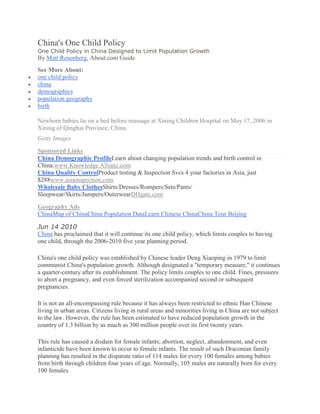
China's one child policy
- 1. China's One Child Policy One Child Policy in China Designed to Limit Population Growth By Matt Rosenberg, About.com Guide See More About: one child policy china demographics population geography birth Newborn babies lie on a bed before massage at Xining Children Hospital on May 17, 2006 in Xining of Qinghai Province, China. Getty Images Sponsored Links China Demographic ProfileLearn about changing population trends and birth control in China.www.Knowledge.Allianz.com China Quality ControlProduct testing & Inspection Svcs 4 your factories in Asia, just $288www.asiainspection.com Wholesale Baby ClothesShirts/Dresses/Rompers/Sets/Pants/ Sleepwear/Skirts/Jumpers/OuterwearDHgate.com Geography Ads ChinaMap of ChinaChina Population DataLearn Chinese ChinaChina Tour Beijing Jun 14 2010 China has proclaimed that it will continue its one child policy, which limits couples to having one child, through the 2006-2010 five year planning period. China's one child policy was established by Chinese leader Deng Xiaoping in 1979 to limit communist China's population growth. Although designated a "temporary measure," it continues a quarter-century after its establishment. The policy limits couples to one child. Fines, pressures to abort a pregnancy, and even forced sterilization accompanied second or subsequent pregnancies. It is not an all-encompassing rule because it has always been restricted to ethnic Han Chinese living in urban areas. Citizens living in rural areas and minorities living in China are not subject to the law. However, the rule has been estimated to have reduced population growth in the country of 1.3 billion by as much as 300 million people over its first twenty years. This rule has caused a disdain for female infants; abortion, neglect, abandonment, and even infanticide have been known to occur to female infants. The result of such Draconian family planning has resulted in the disparate ratio of 114 males for every 100 females among babies from birth through children four years of age. Normally, 105 males are naturally born for every 100 females.
- 2. Recent Effects of the One Child Law Now that millions of sibling-less people in China are now young adults in or nearing their child- bearing years, a special provision allows millions of couples to have two children legally. If a couple is composed of two people without siblings, then they may have two children of their own, thus preventing too dramatic of a population decrease. Although IUDs, sterilization, and abortion (legal in China) are China's most popular forms of birth control, over the past few years, China has provided more education and support for alternative birth control methods. Statistically, China's total fertility rate (the number of births per woman) is 1.7, much higher than slowly-declining Germany at 1.4 but lower than the U.S. at 2.1 (2.1 births per woman is the replacement level of fertility, representing a stable population, exclusive of migration). In 2007, there were reports that in the southwestern Guangxi Autonomous Region of China, officials were forcing pregnant women without permission to give birth to have abortions and levying steep fines on families violating the law. As a result, riots broke out and some may have been killed, including population control officials. The Future of China's One Child Law China's eleventh Five-Year Plan Period is from 2006 to 2010. Minister of the State Commission of Population and Family Planning Zhang Weiqing confirmed in early 2006 that China's one child policy is consistent with the nation's plan for population growth and would continue indefinitely. He denied rumors that the policy become less stringent to permit a second child. http://geography.about.com/od/populationgeography/a/onechild.htm
